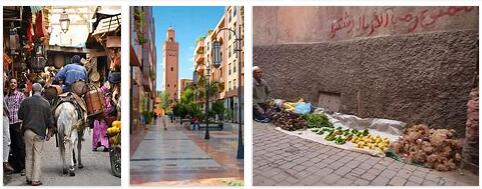Population. – The census carried out in French Morocco on March 8, 1936 gave a population of 6,296,012 residents of which 6,059,509 Moroccans and 236,503 foreigners. Among the latter there were 177,018 French, 23,645 Spaniards and 15,645 Italians. Of the indigenous people 5,898,197 are Muslims and 161,312 Jews. The census notes a considerable increase in the population of some urban centers. Casablanca (the most considerable of all) reaches 258,567 residents, of which 75,349 are Europeans. Fez has 144,343, of which 9553 are European.
Economic conditions. – Morocco’s economic conditions have been severely affected by the general crisis, and so far there has been no hint of a notable recovery. Thus the import trade fell from about 2 billion in 1931 to 1139 million in 1935; that of export from 1275 million in 1928 to 621 in 1935; agricultural crops, which form the main resource, show a decrease in wheat production, which fell to only 3,604,000 quintals in 1936, while barley is on the rise (15,300,000). Wine production was only 450,000 hectoliters, about a third of that of Tunisia; that of olive oil of 65,000 quintals, just over double that of Tripolitania. On the other hand, the importance of sheep breeding and the production of wool which in 1935 reached almost 10,000 tons, almost equivalent to Italian production. As for the mining production, especially represented by phosphates, the quantity fluctuates between one and two million tons, slightly lower than that of Tunisia. In Spanish Morocco there was a considerable increase in the production of iron ore which in 1935 rose to 1,168,000 tons.
Communications and ports. – The government of the protectorate continues briskly in its efforts to develop the road network more and more. A significant improvement represents the construction of the Fez-Oudjda railway of the development of km. 355, inaugurated on May 24, 1934, which joins the Moroccan network with the Algerian and Tunisian ones, forming a continuous whole from Tunis to Morocco (Marrakech).
Finance. – The repercussions of the general crisis in French Morocco, especially serious for the agricultural economy, as well as a particular development crisis in the country and bad agricultural years, strongly affected budget revenues, aggravating the deficit in 1934 and forcing in 1935 to intensify the compression of expenses has already begun. Despite the persistence of poor harvests, the situation in 1937 could however be considered to be improving, thanks above all to the rise in cereal prices. The Moroccan franc followed the events of the French one (see france, App.) And from 31 December 1936 it is no longer convertible into gold but into French francs. As of December 31, 1937, notes in circulation amounted to 550 million and reserves were 103 million in gold and 450 in French francs. The results of the revaluation of the reserves were made available to the government, for extraordinary economic and social expenses.
In the Spanish area, following the war, two coins of different values are currently in circulation: the Bank of Spain notes stamped by the government of Burgos and those without stamps which are legal tender for the government of Valencia.
The depreciation of the Spanish currency greatly disturbed the monetary regime in the Tangier area, so on December 28, 1936 a law was passed that suspends the legal tender of the peseta: so that the only legal tender is now the Moroccan franc. For Morocco 2012, please check eningbo.info.
Dantesque Encyclopedia
Morocco (Morrocco). – Region that occupies the extreme western edge of Africa, corresponding to the Magrib al Aqsa (the extreme west) of Arab geographers; it overlooks the Mediterranean and the Atlantic.
It has been inhabited since prehistoric times. In the 4th century BC the independent kingdom of Mauretania was formed there which, after the Roman conquest, which took place in 42 AD, was divided into two provinces. After the passage of the Vandals, and after the Byzantine occupation, which was of little importance, it happened between the secc. VII and VIII, the Arab conquest, which had considerable consequences for the spread of the Muslim religion and for the introduction of the Arabic language. At the time of D. dal Morocco, which was ruled by sovereigns of the Merinid dynasty, a part of the wool negotiated by the Florentines came (Davidsohn, Storia IV II 839).
In Pg IV 139 D. makes use of Morocco for an indication of time in an astronomical key: And the poet already went up to me, / and said: “Vienne omai; see that it is touched / meridian by the sun, and to the shore / he covers the night already with the Morrocco foot “.
It is noon in Purgatory, therefore midnight in Jerusalem; it is dawn at the mouth of the Ganges, 90 ° east of Jerusalem in Dante’s conception of the great shoal (If XXXIV 113), it is sunset, that is the beginning of the night, which already covers it on the shore… with the foot (Ovid Met. II 142-143 “Dum loquor, Hesperio positas in litore metas / umida nox tetigit”), in Morocco. Morocco, better its northern extremity, indicates the extreme west, 90 ° west of Jerusalem; has the same reference value as Gade (v.), Ibero (v. EBRO), Seville (v.). For the question see also JERUSALEM.
In If XXVI 104 Ulysses, in the description of his travels, says: I saw both sides of Spain, / as far as Morrocco, and the island of the Sardinians, / and the other than that sea around wet.
The Moroccan coast indicates the western end of the African coast washed by the Mediterranean. And it is the city of Morocco one of the two cities that Ulysses passes before crossing the Pillars of Hercules: Ceuta (v.), The Dante sect of v. 111. Casella maintains that for step D. he had a land map built according to the geographical description of Orosio. Finally, it should be remembered that the Anonymous places Morocco in Spain.
